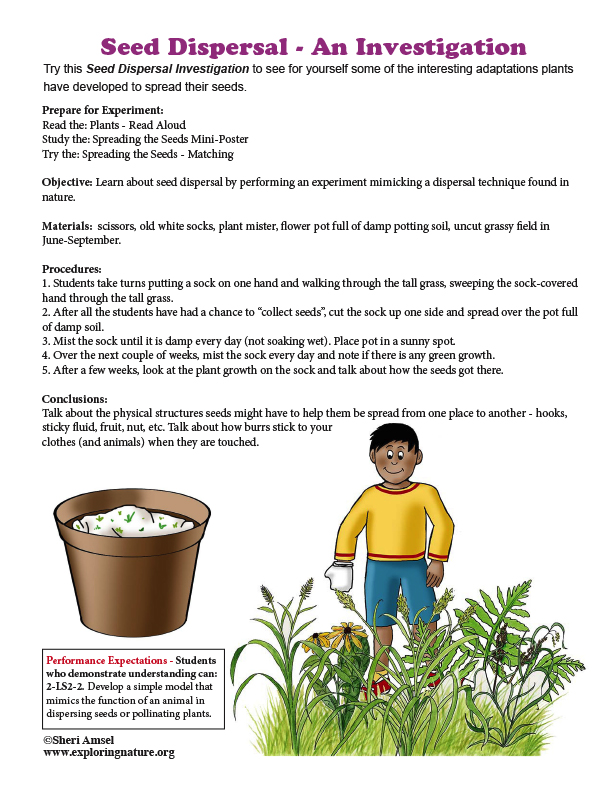

Try this Seed Dispersal Investigation to see for yourself some of the interesting adaptations plants have developed to spread their seeds.

Prepare for Experiment:
Read Seed Dispersal.
Do the Seed Dispersal Matching.
Prepare for Experiment:
Read the: Plants - Read Aloud
Study the: Spreading the Seeds Mini-Poster
Try the: Spreading the Seeds - Matching
Objective: Learn about seed dispersal by performing an experiment mimicking a dispersal technique found in nature.
Materials: scissors, old white socks, plant mister, flower pot full of damp potting soil, uncut grassy field in June-September.
Procedures:
1. Students take turns putting a sock on one hand and walking through the tall grass, sweeping the sock-covered hand through the tall grass.
2. After all the students have had a chance to “collect seeds”, cut the sock up one side and spread over the pot full of damp soil.
3. Mist the sock until it is damp every day (not soaking wet). Place pot in a sunny spot.
4. Over the next couple of weeks, mist the sock every day and note if there is any green growth.
5. After a few weeks, look at the plant growth on the sock and talk about how the seeds got there.
Conclusions:
Talk about the physical structures seeds might have to help them be spread from one place to another - hooks, sticky fluid, fruit, nut, etc. Talk about how burrs stick to your
clothes (and animals) when they are touched.
Critical Thinking:
1. Which human inventions may have mimicked these adaptive structures in plants?
2. Explain the irony in this Seed Dispersal Comic.
Performance Expectations: 2-LS2 Ecosystems: Interactions, Energy, and Dynamics
Plan and conduct an investigation to determine if plants need sunlight and water to grow. 2-LS2-1
Develop a simple model that mimics the function of an animal in dispersing seeds or pollinating plants. 2-LS2-2
When you research information you must cite the reference. Citing for websites is different from citing from books, magazines and periodicals. The style of citing shown here is from the MLA Style Citations (Modern Language Association).
When citing a WEBSITE the general format is as follows.
Author Last Name, First Name(s). "Title: Subtitle of Part of Web Page, if appropriate." Title: Subtitle: Section of Page if appropriate. Sponsoring/Publishing Agency, If Given. Additional significant descriptive information. Date of Electronic Publication or other Date, such as Last Updated. Day Month Year of access < URL >.
Amsel, Sheri. "Seed Dispersal - An Investigation" Exploring Nature Educational Resource ©2005-2024. December 15, 2024
< http://exploringnature.org/db/view/Seed-Dispersal-An-Investigation >